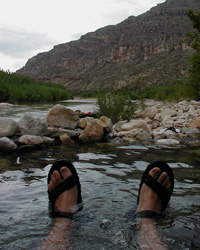 |
 | |
  | |
|
|
|
|
Big Bend National Park
Hot Springs / Geothermal Areas
|
|
|
|
|
|
 |
 |
| NPS/Tom VandenBerg | | Soaking in a Lower Canyons hot spring. |
 |
Along a stretch beginning upstream of Rio Grande Village, a series of thermal springs emerge adjacent to the Rio Grande. All of the hot springs in this region are believed to be related to normal faults. These Basin and Range type faults formed between 18 and 23 million years ago. Today, groundwater circulating deep in the earth becomes heated before it returns to the surface as hot springs.
The Langford Hot Springs
The most famous of the thermal features along the Big Bend of the Rio Grande is the Langford Hot Springs. Located where Tornillo Creek enters the Rio Grande, some four miles upriver from Boquillas Canyon and the Mexican village of Boquillas. The natural springs at the site are known as Boquillas Hot Springs. Boquillas is Spanish for "little mouths" and refers to the many small streams or arroyos that drain this part of the Sierra del Carmen range and flow into the Rio Grande. Later, when the springs were promoted for their health benefits, the settlement and spa resort there was called Hot Springs, and a post office by that name was established at the site in July 1914. Although there are several other small hot springs in the area, these larger and more accessible springs are the best known.
The temperature of the springwater, which is heated geothermally, is 105°F year-round; the water contains calcium carbonate, calcium sulfate, sodium sulfate, sodium chloride, and lithium. The springs' flow rate in 1936 was 250,000 gallons a day, but more recent measurements show a decrease.
|
|  |  |

|
 |
|
|
|
|
|
 |
|
Did You Know?
If there was ever a Spanish gold or silver mine any place in the Chisos Mountains, it has not been found. The rocks in the high Chisos Mountains peaks that can be seen from the old Presidio de San Vicente are lavas of volcanic origin, and gold and silver do not usually occur in such an environment.
more...
|
|
|
|
Last Updated: August 31, 2006 at 13:57 EST |






